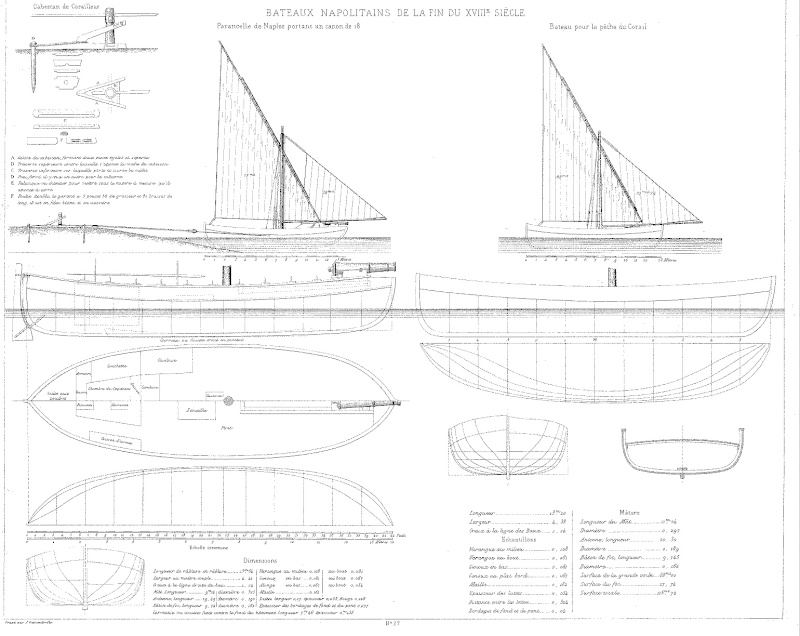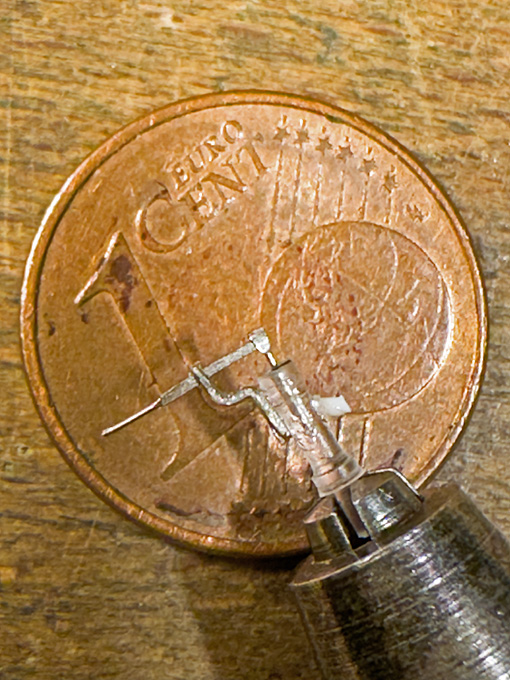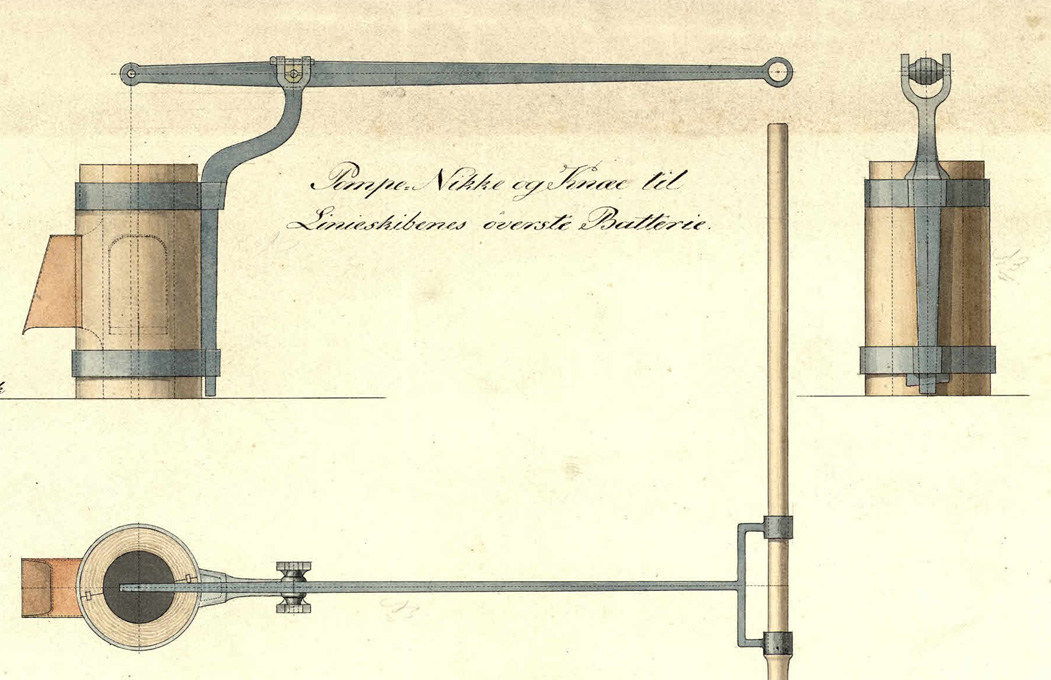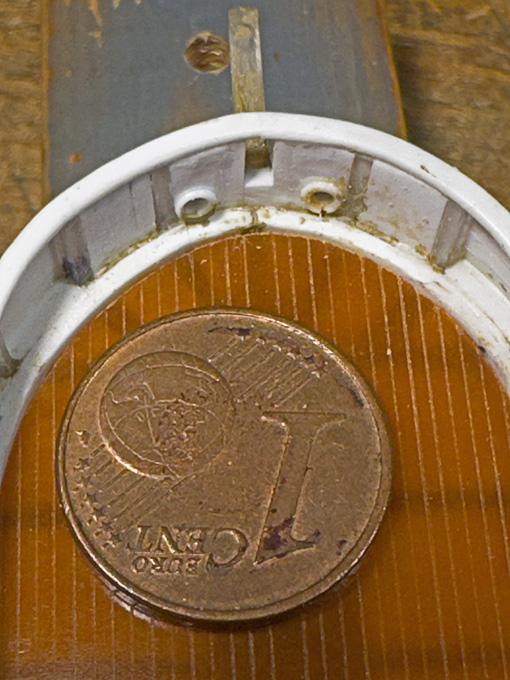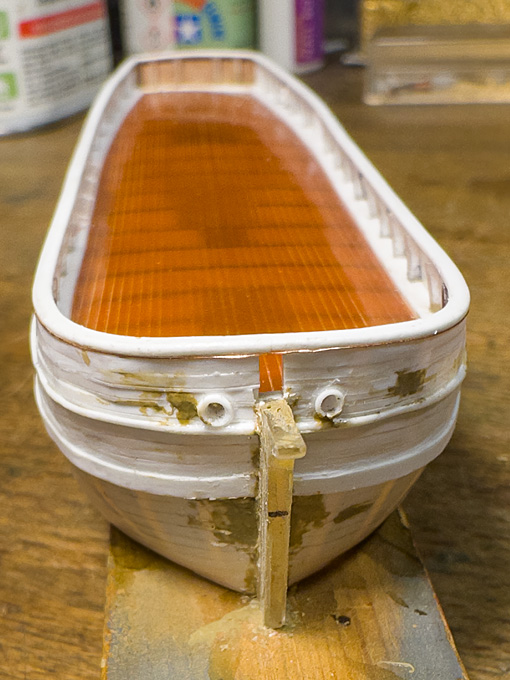-
Posts
6,651 -
Joined
-
Last visited
Content Type
Profiles
Forums
Gallery
Events
Everything posted by wefalck
-

Good 'Hobby Quality' Metal Lathes
wefalck replied to tmj's topic in Modeling tools and Workshop Equipment
Remember that double-slotted collets, such as the ER-type are designed for holding tools or round stock. The material has to go through the whole length of the collet or nearly so. Pieces of less than half the length of the collet cannot be securely clamped, as tightening the collet has the tendency to squeeze the part out of the collet ... there is also the risk of damaging the collet in this way. -
Well, this slot under the lowest bulwark-plank seems to have common feature on smaller vessels all around the Baltic and Scandinavia, particularly, when the water-way was more or less flush with the deck. I have seen many original vessels and models like this. Another option would have been hinged freeing ports that were locked in fine weather with a latch. The freeing ports are essentially the lowest bulwark-plank divided into sections that are individually hinged. I will discuss this particular feature in the forthcoming post on my building-log for a Rahschlup. In the 1870s seaboots commonly would not have been rubber although such boots seem to have been manufactured since the middle of the century. They were oiled leather, above knee-length and had either wooden or heavy leather soles with hob-nails. In the Arctic, rubber-boots would have been impractical, as the rubber becomes stiff and brittle, prone to cracking and also conducts heat much better than leather - cold feet guaranteed in spite of heavy woolen socks.
- 54 replies
-
- Northwest passage
- Norway.
-
(and 2 more)
Tagged with:
-

Good 'Hobby Quality' Metal Lathes
wefalck replied to tmj's topic in Modeling tools and Workshop Equipment
A topic one can discuss for hours and there are already several threads on this topic here on the forum. As @toolmaker said, the first thing to do is to make a list of the enveloppe you think you will need and of the capabilities required - then go for a lathe about twice the size. One always underestimates the distance between centres and swing needed (BTW, in the US the 'swing', i.e. the maximum diameter of parts is given, while in Europe it is the centre height, i.e. the height above the bed or the radius!). The next key question is, whether you think that one day you may want to cut threads: neither old Unimat nor the Taig doesn't have this capability ex-factory, but there are several suggestions for retro-fitting on the Internet; the Sherline has this as an extra to be purchased; the medium to larger PROXXON models and the the Cowells ME lathe have the capability build in; the various modern Chinese lathes have this capability, but (plastic) change-wheels may need to be purchased as an extra; classical watchmaking lathes do not need thread-cutting capability, but it was offered for some of the WW-type models (Lorch, Schmidt & Co., Wolf, Jahn & Co., Boley, Leinen, and Levin), but prices on the secondhand-market tend to be astronomical. Personally, I prefer working with collets, rather than three- or four-jaw chucks. Much safer and much better repeatability. Not all lathes have a spindle-cone to take in collets, for some so-called collet-chucks are/were available (Unimat, Proxxon). The Sherline has a spindle-cone and a limited range of collets is available, but with an adapter, standard WW-type watchmaking collets can used (available from Sherline, albeit not the same quality as the original ones). On watchmaking lathes collets are a standard feature. The 'feel' while working with the handwheels or ball-cranks is important, how smooth are the spindles and what about backlash (the amount you can turn the wheel before a movement of the slide occurs), can it be adjusted? Related to this is how smoth the slides work and how well the adjustment via gib-strips work. These features can vary from individual lathe to individual lathe. For me these are crucial features to achieve good results. Another question to consider is, whether one has the space for a permanent set-up or has to move the lathe into storage after use. In the latter case, the Chinese and larger PROXXON lathes are probably out, because they tend to be too large and heavy. The old-time Unimat came with a nice storage case, as did normally all watchmaking lathes. Otherwise, the Sherline and Taig seem to be quite mobile. And one more thing to consider: the cost of (quite essential) accessories, such as chucks, collets, tooling etc. can be as high as the basic lathe. BTW, engine and watchmaking lathes in their 'modern' form have been around since the 1870s to 1880s, not only since the 1920s. Strangely enough many watchmakers/-repairers today still prefer to work with handgravers rather than sliderests with toolbits (as on engine lathes) - this works for the generally short workpieces they need, but making multiple parts to the same dimensions with this method is a pain unless you are well-practiced. The handgraver together with a so-called T-rest (inexplicably expensive attachment to the Sherline ...) is excellent for shaping parts such as bells. Another point: Babbitt-bearings to the best of my knowledge were never used on such small machine tools. They were not suited to the high speeds at which these machines commonly run (typically between 1000 and 5000 rpm) and probably would not be precise enough. Cheaper machines originally used lapped bronze cone-bearings in which hard steel spindles ran, while the high-end watchmaking lathes have glass-hard steel cone-bearings in which glass-hard steel spindles run. Today model-engineering lathes usually have either a combination of radial and axial ball-bearings or taper roller-bearings that take up both, axial and radial loads. -
I noticed this feature on the bridges of 'modern' (from my point of view) ships, but never thought about their purpose and function. Thanks for the explanation, makes perfect sense to use the Venturi-effect for deflecting the air-stream.
- 476 replies
-
- minesweeper
- Cape
-
(and 1 more)
Tagged with:
-
Very French looking crowd indeed and the scene comes together 👍🏻 Talking about moustaches, while they give some of the characters their 'Frenchness', I thought since Ypres 1915 big moustaches were against the regulations designed to fit gas-masks tightly, which is why post-war big moustaches went out of fashion.
-
You made me blush ... Anyway, your paint samples above seem to be extemely expensive. I don't know anything about artmaterial prices in the USA, but here in Europe I would probably not want to pay more than something in the order of 10€. Watch out for 'study' acrylics, that tend to be cheaper, though the pigment may not have been as finely ground as for the top-notch paints - but that is good enough for modelling. Her colour-scheme was already a bit outdated at the time, as in the last quarter of the 19th century black with some white trimmings began to prevail. Bevor, it was common to have coloured hulls, mainly green and blue, besides black, but the wales were often scraped and oiled, and acompanied by strakes in white, sometimes red, or on black hulls in green or blue - at least over here in Europe. Norway may have retained the colourful schemes for longer to brighten the short winter days 😉
- 54 replies
-
- Northwest passage
- Norway.
-
(and 2 more)
Tagged with:
-
... but forbidden today, I believe, because it leaves also a lot of broken corals behind, which take decades to re-grow.
-
It is not a boat from the Adriatic, but rather from the coast of Campania down to Sicily (as is written on the box). The kit seems to be based on a Napoletan paranzella, plate 27 of Paris' 'Souvenirs de la Marine'. More information on these boats from the western coast of Italy can be found (p. 164-167) in this book: BELLABARBA, P., GUERRERI, E. (2003): Vele italiane della costa occidentale dal Medioevo al Novecento.- 277 p., Milano (Editore Ulrico Hoepli).
-
I am not an engineer, but I have a bit of an engineer's mind and my natural tendency would be to work off drawings and measurements taken off drawings. However, I realised that 'as built' is never 'as drawn' - and was never so in the world of real ship building. So it is a good idea to fit new pieces in situ to parts already existing. I kind of learned this, when I was working together with professional builders on renovating our house. They never cut wood according to the drawings, but always took the real measurements from the parts already in place. Having said that, I think my strategy would have been to first build the breastwork structure with its stanchions and rails and then fit the decorative lattices into the resulting spaces ...
- 2,699 replies
-
- heller
- soleil royal
-
(and 9 more)
Tagged with:
-
These comments may come a bit late, I know. I don't know, whether the museum in Oslo ever undertook any research on the different layers of paint on GJØA in order to understand what the original colour might have been. I suspect it would have been a chromium oxide green with some lead-white mixed in to stretch, which was common at the time. Unfortunately the current multi-coloured 'disco' lighting in the museum makes it difficult to judge the real colours.
- 54 replies
-
- Northwest passage
- Norway.
-
(and 2 more)
Tagged with:
-
This column of wide doors with a hoist above is a common feature on warehouses, mills and any place that needs to hoist material to different floors. In the Netherlands, Northern Germany and the Baltic States, one finds such hoists even on private houses, as staircases were often too narrow to bring in furniture or let alone pianos.
-
I think I said something like that before, but I love those 'shanty-boats' (as in shanty-towns), these improvised thingies of a kind, one would have rarely seen anymore in regulated early 20th century Europe. It also shows a kind of live that has largely disappeared since the 1950s, where whole families were living on workboats and where husband and wife (and possibly children) shared the work.
-
Thanks again to all for their encouragement ! ********************************************** Some small progress in the true and literary sense of the word: Bilge-pump Although not drawn in the original drawings, the ship must have had at least one bilge-pump. Such pumps would be logically located at the lowest part of the hull, usually somewhere close to the mast. As its location is not marked on the drawings, this is a bit of guess-work. While Downton-pumps or similar existed already, when the Rahschlup was designed, they were comparatively expensive items. As the ship was built in a rather economically marginal context, it is more likely that a traditional wooden pump was installed, that could also be built and maintained with local materials and by local craftsmen, such as a blacksmith. Nicely rendered drawings for such pumps can be found, for instance, in the Danish naval yard archive. Example for a bilge-pump from the former Danish naval yard (extract from G-2357-09) The trunk would have been fashioned from a single tree, typically elm, that was bored out with the aid of spoon- or canon-drills in a sort of primitive boring-lathe. Iron bands kept it together and served as attachment points for the lever. https://youtu.be/pj-XKqW29XE?si=9Q8RTsXOMxMuPPVN Example for drilling of wooden pipes. I made a rough sketch to fix the dimensions and settled on a height of 4 mm and a diameter of 1 mm, which would be 64 cm and 16 cm on the original respectively. The body was turned from a short length of acrylic rod, leaving the future bands as proud rings. The mechanism is composed of four lengths of 0.2 mm tinned copper wire. The wire was first bent to shape and flattened at the appropriate places with a special kind of flattening pliers. Initially, I intended to solder the parts together, but they were just too small and flimsy, so I settled on cementing them together with lacquer. The procedure is a bit difficult to document photographically while doing it, so there are only pictures of the finished product. The completed bilge-pump I am afraid the translucent pump does not show very well in the photograph, but I generally only paint everything at the very end to avoid damage during repeated handling. To be continued …
-
Brilliant to see you back at this work 👍🏻 One is always a bit apprehensive, when there is a long period of silence. I forgot about your home-improvement trials and tribulations. Having gone through a couple of home renovations myself, I know what the challenges are and that one has to constantly keep the contractors on their toes. Luckily, our constractor very early on understood, that his client knows a bit about the business 😈
-
Hawse-pipes Hawse-Pipes As I was dealing with fairleads through the bulwark, I decided to continue with the hawse-pipes as well. After some deliberation, I also decided to go fully ‘plastic’. In the past I fashioned the hawse-pipes and the entry-/exit-reinforcements from brass tubes with rings soldered on. Set-up in the horizontal milling machine for drilling the hawse-pipes Here the actual pipes are very short and go through a massive layer of polystyrene. So, a separate pipe is not really needed. For drilling the 1 mm holes, the model was set up on the horizontal milling machine. The reinforcement rings were cut from 0.5 mm diameter polystyrene rod (or perhaps rather wire). To this end, the polystyrene wire was wound around a 0.9 mm drill-shaft, which was easier than expected, and then the springiness was taken out by slightly tempering it at 100°C with my hot-air soldering gun. From this spiral, the rings were cut. The rings then were sanded flat on one side and cemented to the bulwark outside and inside. A first try with polystyrene cement was not very successful, as the ring began to spread open upon contact with the solvent. I then used the artificial-nail cement, composed of acrylic solution and cyanoacrylate. After the cement had cured, the hole needed to be bored out again and smoothed. Outboard view of the hawse-pipes Inoard view of the hawse-pipes As sobering these close-ups are with respect to cleanliness and crispness of the execution of the work are, they also show strikingly, where touching-up is really needed – not something that one sees very easily even using magnifying glasses. To be continued …
-
There may be an element of truth that 'green' was considered unlucky. A common pigment, that was first synthesised in 1802 is Schweinfurt Green, which is copper(II)-arseniteacetate and is poisenous. It was widely used, even in the manufacture of wallpaper and home-paints. In the country of its origin, the pigment was forbidden already in 1882, but its use in antifouling paints permitted.
-
That would be the subject of a book that I wanted to write for a long time (being a geochemist by training). You are absolutely right, that certain pigments were too expensive for rough shipboard use and others would not have been sufficiently lightfast. So, Boudriots list is a good starting point, as it mainly contains natural earth pigments that meet both requirements, beeing cheap and being stable. One would need to precise which decades of the 19th century we are talking about, as the pigment industry rapidly evolved in the course of the century. The evolving (industrial) chemistry led to the capability of synthesing certain pigments and thus becoming independent from the varying quality of natural mineral pigments. The increasing availability of by-products from coal-gasification from the 1840s on, lead also to the development of tar- and phenol-based artificial pigments towards the end of the 19th century. Interestingly, while the range and availability of pigments increased, from the 1860s on, ships became more sombre in livery, with black and white dominating, with the exception of spars and funnels that were ochre. Between the 1820 and the 1860s, ships were often quite colourful, with inside bulwarks, deckhouses, and the tips of spars painted in pastel ochre, green, or blue. With these pastel colours, a small amount of pigment could go a long way, when mixed with a white base pigment. BTW, the off- or dirty white mentioned in the literature is due to cheap and not very well refined lineseed oil and resins that yellows upon oxidation. This also makes coloured pigments dull. And from the mid-1860s on commercial antifouling paints in a variety of colours became available, not only in red ochre, but also in greens, blues, and browns.
About us
Modelshipworld - Advancing Ship Modeling through Research
SSL Secured
Your security is important for us so this Website is SSL-Secured
NRG Mailing Address
Nautical Research Guild
237 South Lincoln Street
Westmont IL, 60559-1917
Model Ship World ® and the MSW logo are Registered Trademarks, and belong to the Nautical Research Guild (United States Patent and Trademark Office: No. 6,929,264 & No. 6,929,274, registered Dec. 20, 2022)
Helpful Links
About the NRG
If you enjoy building ship models that are historically accurate as well as beautiful, then The Nautical Research Guild (NRG) is just right for you.
The Guild is a non-profit educational organization whose mission is to “Advance Ship Modeling Through Research”. We provide support to our members in their efforts to raise the quality of their model ships.
The Nautical Research Guild has published our world-renowned quarterly magazine, The Nautical Research Journal, since 1955. The pages of the Journal are full of articles by accomplished ship modelers who show you how they create those exquisite details on their models, and by maritime historians who show you the correct details to build. The Journal is available in both print and digital editions. Go to the NRG web site (www.thenrg.org) to download a complimentary digital copy of the Journal. The NRG also publishes plan sets, books and compilations of back issues of the Journal and the former Ships in Scale and Model Ship Builder magazines.




